|
 Tremellodendropsis flagelliformis Tremellodendropsis flagelliformis
SynonymsLachnocladium flagelliforme
Tremellodendropsis flagelliformis var. ovalispora
Clavaria flagelliformis
Tremellodendropsis flagelliformis var. flagelliformis
Aphelaria flagelliformis
BiostatusPresent in region - Indigenous. Non endemic
Images (click to enlarge)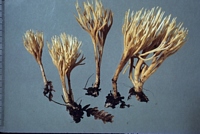
Owner: Herb PDD | 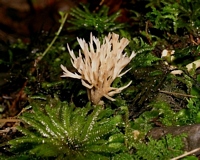
Owner: J.A. Cooper | 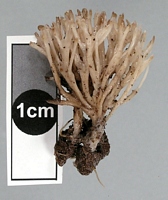
Owner: J.A. Cooper | 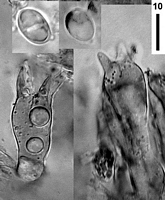
Caption: spores and partially cruciate basidia.
Owner: J.A. Cooper | 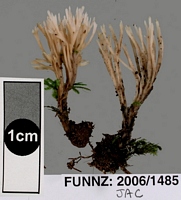
Owner: J.A. Cooper | 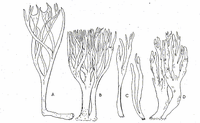
Caption: Tremellodendropsis flagelliforinis var. ovalispora. A. & B. Type collection (No. 157). B. Type plant. C. Subsimple plants (No. 240). D. Young rugose plants (No. 165). Magnification x 1.
Owner: Crawford, D.A. |
Article: Crawford, D.A. (1954). Studies on New Zealand Clavariaceae. I. Transactions of the Royal Society of New Zealand 82(3): 617-631.
Description: Fruit body -6 , cm high, caespitose to solitary, flesh dull pink-fawn, basal region whitish, tough when fresh, drying horny fuscous with paler tips: branch¬ing polychotomous and expanded at first, finally dichotomous; branches often terete, especially the ultimates which are subparallel and taper to fine pointed tips, or in some shorter stouter plants flattened with more rounded, blunter tips.
Spores 7-11 x 5-7 (-7.7) µm white, smooth, thin walled with granular contents, bluntly ellipsoid to lachrymiform; apicule subterminal –1.6 µm.
Basidia 1, 2 or 4 spored, 60-95 µm long x 10-11 µm wide, tapering to 3-4 µm at base, cruciately subseptate, septa extending 4-9µm down into basidia, clamped at base sterigmata 6-14 µm long x 2-5 µm, tapered, erect with a slight outward curvature. Some sterigmata elongate, forming hypha-like projections 1.7 µm wide, with rounded ends. (In specimen No. 114 some old basidia up to 94 µm long, embedded in. the thickening hymenium, had become once or twice septate; c.f. some Clavulina species. No young basidia were septate. )
Hymenium thickening –95 µm composed of mature basidia and narrow un¬expanded hyphal ends mostly derived from the elongation of old sterigmata; absent from base of the stem.
Hyphae 2.5-3.5 µm wide, monomitic, not inflated, clamped, walls slightly thickened.
Distribution: DISTRIBUTION: Bay of Islands, and Wellington, New Zealand, also Brazil and Sumatra (Corner, 1953, p. 350).
Notes: The above description is based on the type and on collection Nos. 105 and 114, from Keith George Memorial Park, Wellington, and No. 206, Waikaremoana, Nth. Is., New Zealand. From the description of specimens from Brazil and Sumatra, (Corner 1953, p. 350) it is probable they are specimens of T. flagelliformis, but without detail of basidia one cannot be absolutely certain.
|